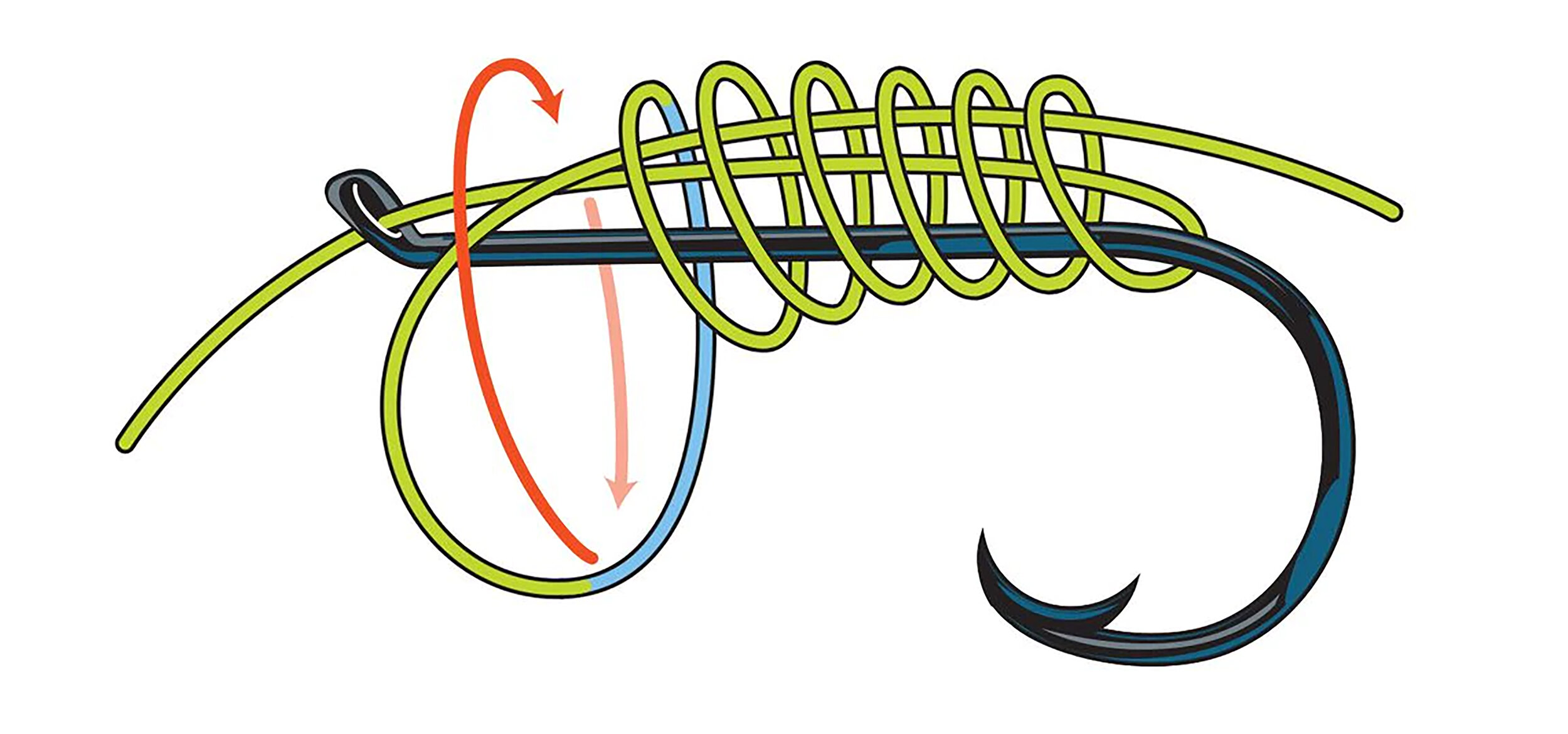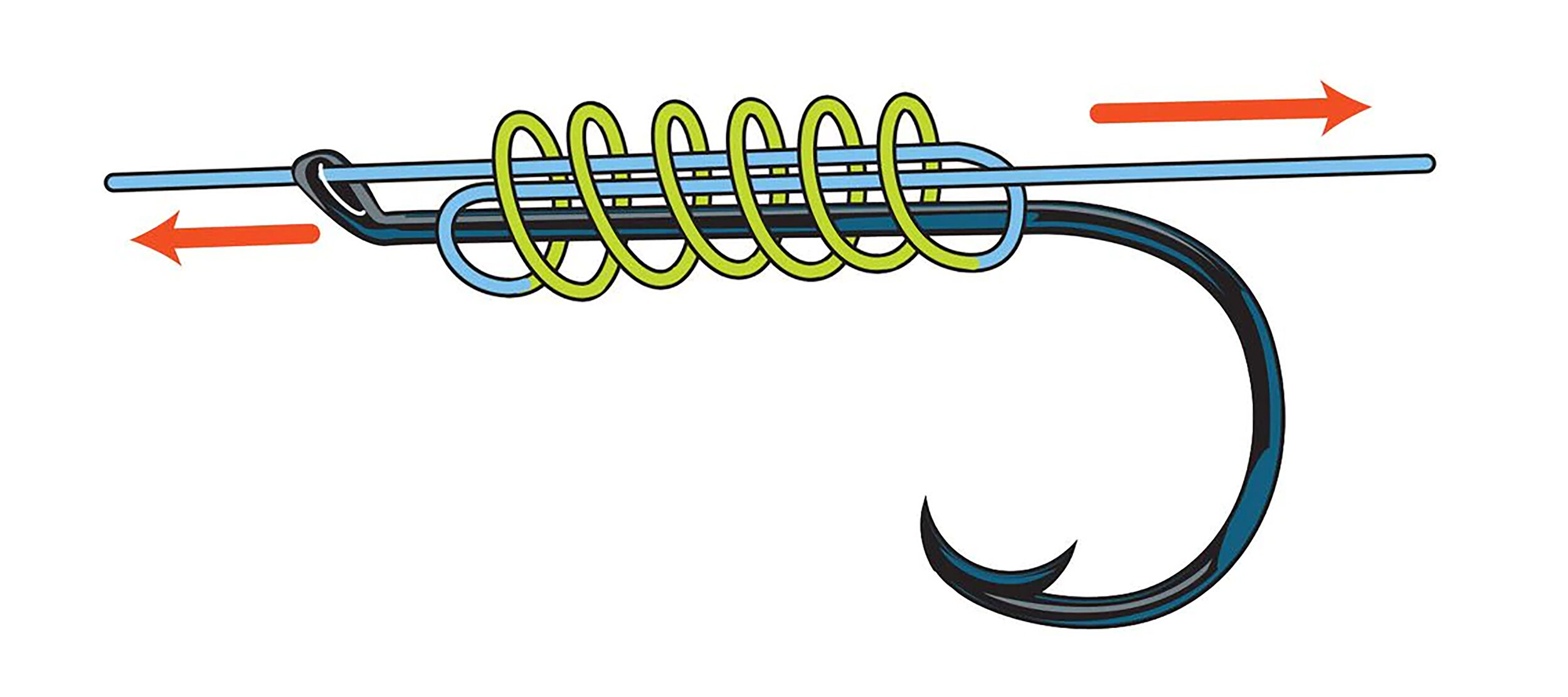How to Snell a Hook
By Sam Hudson / Updated October 9, 2019
Do you remember in the early 2000s when pork was branded "the other white meat"? I think of snelling a hook as "the other fishing knot." Although not as common as everyday knots, the versatile snell knot can be used with different styles of hooks, different techniques and different strength leaders. Plus, it's easy to tie.
While researching this column, I realized just how many ways there are to snell a hook, whether it’s a Uni-style or traditional snell wrap. You can thread the terminal end of the leader through the eye of the hook once, twice or not at all before making your wraps, or you can complete your wraps toward or away from the hook eye. No matter which method you use to snell, insight from these experts can help you get the most out of these clean connections. What do you believe is the best way to snell a hook?
Watch out for curlicues coming from snells. The leader should be clean all the way to the knot; always wet the knot before tightening down. Jon Whittle
Use A Snell Knot When Live-Baitin
Capt. Dean Panos, of Double D Charters in Miami, favors snelled hooks whenever he needs a connection tight to the hook, as opposed to one that's free-swinging, such as a loop knot. For him, applications include live-baiting for yellowfin tuna or yellowtail snapper, or pitch-baiting dead ballyhoo for blue marlin.
“Fluorocarbon, in my opinion, does not tie very well,” says Panos. “Snelling provides a very good connection. Anglers must make sure they are snelling their circle hooks correctly, so at the bite, when the line pulls tight, the hook turns upward toward the fish — not downward away from the fish.”
Left: Notice that single strand of leader snaking over the wraps? That’s a sure sign the snell was tied with the wraps directed toward the hook point. Right: This snell was tied with the wraps headed toward the eye of the hook. IGFA tests found that this knot tests at higher pounds of pressure. Jon Whittle
Use Snell Knots with Circle Hooks
"I fish for billfish, and unless I happen to be trolling lures, I exclusively use circle hooks, which we always snell," says Capt. Chris Sheeder, of Casa Vieja Lodge in Guatemala.
“Pitch bait, live bait, trolled bait or even a bait-lure combination — anything with bait gets rigged with a circle hook attached via a snell knot.”
In-line, straight-eye circles work incredibly well at hooking billfish in the corner of the mouth, even if a sailfish or marlin initially ingested the bait deep in its gut during the drop-back.
Chris Sheeder explains how to snell a hook:
“Snell a circle hook with the line entering the eye from the hook-point side,” Sheeder explains. “Pulling tight on a fish, the hook has an increased chance of finding the corner resting spot. You won’t get this [result] if you use a circle with a bent eye or insert your leader through the hook eye from the opposite side.”
Before snelling, make sure the hook has a smooth eye. Hook eyes with sharp interior edges can slice your knot at the point where the hook eye closes, says Sheeder. Tying a snell with heavy leader is a chore, and once 125- to 150-pound-test material is necessary, many captains switch over to crimps.
“I suggest using a hook with an eye big enough to run the leader through, going around the shank once and coming back up through the eye to crimp,” says Sheeder. “This gives you the same stiffness of a snell, but instead you’re using a crimp. Still, I believe snelling a hook makes for a stronger connection than crimping.”
If you prefer to snell your straight-eye J hook, make the wraps without going through the hook eye for a strong in-line connection. The leader should head toward the main line on the non-hook-point side. Jon Whittle
Snell Bent Eye Hooks
Bent-eye hooks are tailor-made for attaching via a snell.
One experienced captain who favors bent-eyes is Kenny Koci, of Fin Again Sportfishing in Hatteras, North Carolina. Koci recently made fishing headlines when his boat landed a 138-pound white marlin, a new state record.
“For fishing with tinker mackerel and ballyhoo last year at Norfolk Canyon off Virginia, we snelled our 7/0 and 8/0 bent-eye hooks, depending on the size of the bait. One day we caught 14 white marlin, [and there were] opportunities for tuna and blue marlin.”
Koci feels an angled-eye connection leads to better hookups. He bridles all his baits when slow-trolling, setting out a five-bait spread and tube-squid teasers. "Everything is more in line," he says. "By using the angle in the eye, you're not putting any angle into the leader." By comparison, when tying a snell to a straight J hook, forgo the hook eye completely for a similar effect.
Koci admits that the heavier leader makes snells harder to tie. He commonly uses 80-pound rigs for white marlin and yellowfin tuna, and 100-pound rigs for blue marlin.
“Targeting bigeye tuna, I’ll use crimps with 130-pound fluoro,” he explains. “I actually like a little play in the circle hook when using crimps for the bigeyes.”
The straight-eye circle hook shown here is snelled right to the shank — not through the eye, as shown on the opposite page. The knot passed its test on this Panama bull mahi. Adrian E. Gray
Those Pesky Snell Wrap
When tying a snell knot, consider which direction you wrap your leader around the hook shank. I sent four different snells to the IGFA headquarters in Dania Beach, Florida, where Adrian Gray and Jack Vitek tested the knots on the IGFA’s tensile-strength machine for snell knot strength. The knots were a mix of uni- and traditional-style snells, all of which were wetted down before tightening.
Three of the four snells tied with 30-pound fluorocarbon broke at or near 20 pounds, showing similar breaking points. I should have sent a length of sample leader, plus a hook tied with a double-clinch or uni knot, to compare the leader strength and knot strength to the strength of the snells.
One snell broke at close to 13 pounds, much lower than the other three. The main difference in this snell was that the wraps along the hook shank moved toward the hook point instead of toward the hook eye. From now on, I’ll tie all my snells with the wraps aimed toward the hook eye, even if it’s harder.
Take these basic, unscientific results with a grain of salt. An in-depth knot test on snells would have required many more tests, different leader brands, different pound-tests, and different hook styles from different manufacturers — and following that, a thorough statistical analysis of the results.
“The most important factor is that when you cinch down on the leader, it must be done slowly, and keeping the leader material moist,” says Panos. “If you cinch down quickly and with a dry leader, you can burn the leader and severely weaken the leader material. The leader will break under pressure right at the hook or just above it.”
When Not to Use a Snell Knot
Some captains snell their hooks only for specific situations.
A snelled hook creates a secure — albeit stiff — connection from leader to hook. A snell might not be the best option for anglers who want to give their live baits plenty of freedom to swim and move for a livelier presentation.
"I do very little snelling of hooks," says Capt. Glyn Austin, of Going Coastal Charters in Palm Bay, Florida. "I don't snell when using fluoro or mono leader. I do well live-baiting with a single hook for snook, reds and tarpon, always using a loop knot, which allows the bait to freely swim on the leader whether it's on the bottom or swimming at the surface."
Below are step-by-step illustrations showing one way to tie a snell to a hook. This is how to snell a hook with fluorocarbon or monofilament line.
Thread the leader through the hook eye and create a loop. Kevin Hand
Start wrapping the loop toward the eye of the hook. Kevin Hand
Make sure the wraps hold tight against the shank and don’t overlap each other. Kevin Hand
Seven wraps are all that’s necessary for most lines; lighter leaders need a couple more wraps. Kevin Hand
Pull on the tag end to tighten the knot; straighten the knot to line up with the eye of the hook before tightening down completely. Kevin Hand
Cut off the tag end near the snell. Kevin Hand










